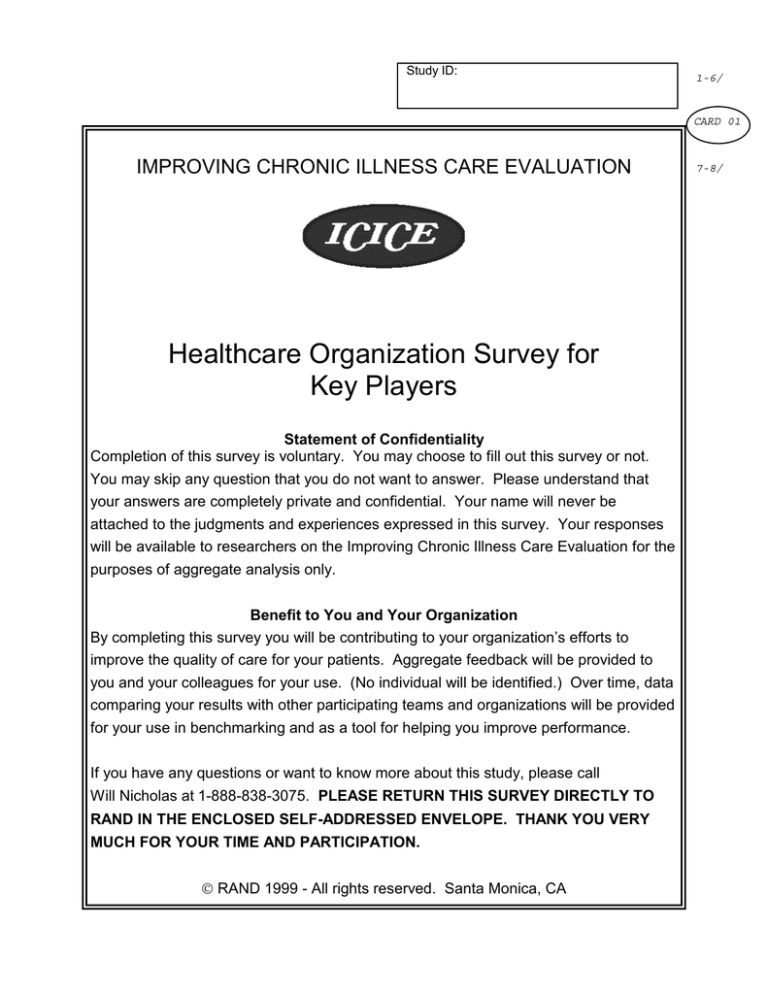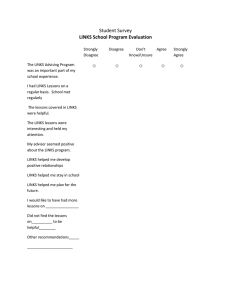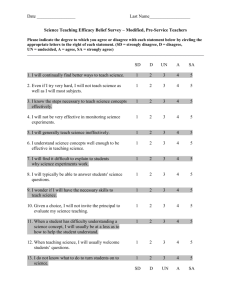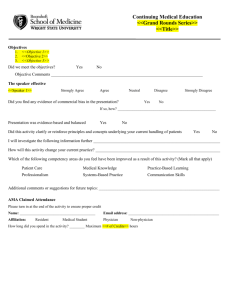
Study ID:
1-6/
CARD 01
IMPROVING CHRONIC ILLNESS CARE EVALUATION
Healthcare Organization Survey for
Key Players
Statement of Confidentiality
Completion of this survey is voluntary. You may choose to fill out this survey or not.
You may skip any question that you do not want to answer. Please understand that
your answers are completely private and confidential. Your name will never be
attached to the judgments and experiences expressed in this survey. Your responses
will be available to researchers on the Improving Chronic Illness Care Evaluation for the
purposes of aggregate analysis only.
Benefit to You and Your Organization
By completing this survey you will be contributing to your organization’s efforts to
improve the quality of care for your patients. Aggregate feedback will be provided to
you and your colleagues for your use. (No individual will be identified.) Over time, data
comparing your results with other participating teams and organizations will be provided
for your use in benchmarking and as a tool for helping you improve performance.
If you have any questions or want to know more about this study, please call
Will Nicholas at 1-888-838-3075. PLEASE RETURN THIS SURVEY DIRECTLY TO
RAND IN THE ENCLOSED SELF-ADDRESSED ENVELOPE. THANK YOU VERY
MUCH FOR YOUR TIME AND PARTICIPATION.
RAND 1999 - All rights reserved. Santa Monica, CA
7-8/
A. THE ORGANIZATION AS A WHOLE
Instructions:
These questions relate to the type of organization that your institution is most
like. Each of these items contains four descriptions of healthcare
organizations. Please distribute 100 points among the four descriptions
depending on how similar the description is to your organization. None of
these descriptions is any better than the others; they are just different. For
each question, please use all 100 points.
For example: In question 1, if Organization A seems very similar to mine, B
seems somewhat similar, and C and D do not seem similar at all, I might give
70 points to A and the remaining 30 points to B.
Please note that these questions pertain to the overall organization of which
you are a part, not to your individual team or unit.
Organization Character (Please distribute 100 points)
1.
_______
Organization A is a very personal place. It is a lot like an extended family.
People seem to share a lot of themselves.
9-11/
2.
_______
Organization B is a very dynamic and entrepreneurial place. People are
willing to stick their necks out and take risks.
12-14/
3.
_______
Organization C is a very formalized and structured place. Bureaucratic
procedures generally govern what people do.
15-17/
4.
_______
Organization D is very production oriented. A major concern is with getting
the job done. People aren’t very personally involved.
18-20/
Total = 100 points
Organization’s Managers (Please distribute 100 points)
5.
_______
Managers in Organization A are warm and caring. They seek to develop
employees’ full potential and act as their mentors or guides.
21-23/
6.
_______
Managers in Organization B are risk-takers. They encourage employees
to take risks and be innovative.
24-26/
7.
_______
Managers in Organization C are rule-enforcers. They expect employees to
follow established rules, policies, and procedures.
27-29/
8.
_______
Managers in Organization D are coordinators and coaches. They help
employees meet the organization’s goals and objectives.
30-32/
Total = 100 points
1
CARD 01
Organization Cohesion (Please distribute 100 points)
9.
_______
The glue that holds Organization A together is loyalty and tradition.
Commitment to this organization runs high.
33-35/
10.
_______
The glue that holds Organization B together is commitment to innovation
and development. There is an emphasis on being first.
36-38/
11.
_______
The glue that holds Organization C together is formal rules and policies.
Maintaining a smooth running operation is important here.
39-41/
12.
_______
The glue that holds Organization D together is the emphasis on tasks and
goal accomplishment. A production orientation is commonly shared.
42-44/
Total = 100 points
Organization Emphases (Please distribute 100 points)
13.
_______
Organization A emphasizes human resources. High cohesion and morale
in the organization are important.
45-47/
14.
_______
Organization B emphasizes growth and acquiring new resources.
Readiness to meet new challenges is important.
48-50/
15.
_______
Organization C emphasizes permanence and stability. Efficient, smooth
operations are important.
51-53/
16.
_______
Organization D emphasizes competitive actions and achievement.
Measurable goals are important
54-56/
Total = 100 points
Organization Rewards (Please distribute 100 points)
17.
_______
Organization A distributes its rewards fairly equally among its members.
It’s important that everyone from top to bottom be treated as equally as
possible.
57-59/
18.
_______
Organization B distributes its rewards based on individual initiative. Those
with innovative ideas and actions are most rewarded.
60-62/
19.
_______
Organization C distributes its rewards based on rank. The higher you are,
the more you get.
63-65/
20.
_______
Organization D distributes its rewards based on the achievement of
objectives. Individuals who provide leadership and contribute to attaining
the organization’s goals are rewarded.
66-68/
Total = 100 points
2
CARD 01
B. QUALITY IMPROVEMENT IN THE ORGANIZATION*
INSTRUCTIONS
In this section you are asked to assess your organization’s efforts to improve the quality of care
and services it provides. Please read each statement carefully. Indicate the extent to which
you agree or disagree that the statement characterizes your organization by circling the
appropriate response (1 = Strongly Disagree, 5 = Strongly Agree). In answering the questions,
you should think about what the organization is actually like now, not how you think it might be
in the future or how you might wish it to be.
RESPONSE CATEGORIES
In circling a response, please keep in mind the following general guidelines regarding the
choices of response categories:
• Circle Strongly Agree when the statement represents a completely accurate description
of your ORGANIZATION.
• Circle Strongly Disagree when the description is completely inaccurate.
• Circle Neither Agree Nor Disagree when you believe the statement is neither a
particularly accurate nor a particularly inaccurate description of your ORGANIZATION.
This situation may arise because there is wide variation in the activities the statement
describes. For example, you might circle neither agree nor disagree when the
statement is true of some departments but not of others.
• Circle Don’t Know if you do not have enough information to answer a question.
GLOSSARY/SPECIAL INSTRUCTIONS
Organization
:
Quality of
Care and
Services:
Senior
Executives:
Middle
Managers:
In responding to questions that ask you to make a global judgment about the
“organization,” please respond based upon your knowledge and experience of
the department or area in which you are currently employed, the other
departments or areas you come in contact within the course of doing your job,
and the information you have on the organization as a whole.
Throughout the survey you are asked to make judgments about the “quality of
care and services provided.” In these questions, “quality of care and services”
refers to how well the organization performs the many activities and functions
involved in patient care.
The term “quality of care and services” is not limited to the technical quality of
care provided to patients; “quality of care and services” is a broader, more
general category that includes not only the technical quality of care, but also
includes how well patient service needs are met.
In general, the senior executives have the overall responsibility for the
operation and administration of the organization. President (CEO,
administrator), senior or other vice presidents, chair or vice chairs of nursing,
and medical director are some of the titles held by people who occupy senior
executive positions. In some organizations, these employees have the title of
associate administrator.
Middle managers include department heads and first line supervisors who are
not part of the senior executive staff.
* Used with permission, Steven M. Shortell and associates, 1999.
3
Strongly
Disagree
Disagree
Neither
Agree Nor
Disagree
Agree
Strongly
Agree
Don’t
Know
LEADERSHIP
1.
The senior executives clearly
articulate the organization’s
values relevant to quality of
care and continuous quality
improvement.
1
2
3
4
5
9
69/
2.
The behavior of the senior
executives is consistent with
values relevant to quality of
care and continuous quality
improvement.
1
2
3
4
5
9
70/
3.
The senior executives have
demonstrated an ability to
manage the changes (e.g.,
organizational, technological)
needed to improve the quality
of care and services.
1
2
3
4
5
9
71/
4.
The senior executives act on
suggestions to improve the
quality of care and services.
1
2
3
4
5
9
72/
5.
The senior executives
generate confidence that
efforts to improve quality will
succeed.
1
2
3
4
5
9
73/
INFORMATION AND ANALYSIS
6.
The organization uses a wide
range of data and information
about the quality of care and
services to make
improvements.
1
2
3
4
5
9
74/
7.
The organization continually
tries to improve how it uses
data and information on the
quality of care and services.
1
2
3
4
5
9
75/
8.
The organization continually
tries to improve the accuracy
and relevance of its data on
the quality of care and
services provided.
1
2
3
4
5
9
76/
9.
The organization continually
tries to improve the timeliness
of its data on the quality of
care and services provided.
1
2
3
4
5
9
77/
4
CARD 01
CARD 02
Strongly
Disagree
Disagree
Neither
Agree Nor
Disagree
Agree
Strongly
Agree
Don’t
Know
7-8/
EMPLOYEE INVOLVEMENT IN
QUALITY PLANNING
10. Staff are involved in
developing plans for improving
quality.
1
2
3
4
5
9
9/
11. Non-managerial staff are
playing a key role in setting
priorities for quality
improvement.
1
2
3
4
5
9
10/
12. Staff have the authority to
correct problems in their area
when quality standards are not
being met.
1
2
3
4
5
9
11/
13. Staff are supported when they
take necessary risks to
improve quality.
1
2
3
4
5
9
12/
14. The organization has an
effective system for
employees to make
suggestions to management
on how to improve quality.
1
2
3
4
5
9
13/
15. Staff are given education and
training in how to identify and
act on quality improvement
opportunities.
1
2
3
4
5
9
14/
16. Staff are given education and
training in statistical and other
quantitative methods that
support quality improvement.
1
2
3
4
5
9
15/
17. Staff are given the needed
education and training to
improve job skills and
performance.
1
2
3
4
5
9
16/
18. Staff are rewarded and
recognized (e.g., financially
and/or otherwise) for
improving quality.
1
2
3
4
5
9
17/
HUMAN RESOURCE
UTILIZATION
5
Strongly
Disagree
Disagree
Neither
Agree Nor
Disagree
Agree
Strongly
Agree
Don’t
Know
QUALITY MANAGEMENT
19. The quality assurance staff
effectively coordinate their
efforts with others to improve
the quality of care and
services the organization
provides.
1
2
3
4
5
9
18/
20. The organization has effective
policies to support improving
the quality of care and
services.
1
2
3
4
5
9
19/
21. The organization works
closely with suppliers to
improve the quality of their
products and services.
1
2
3
4
5
9
20/
22. The organization tries to
design quality into new
services as they are being
developed.
1
2
3
4
5
9
21/
23. The organization views quality
assurance as a continuing
search for ways to improve.
1
2
3
4
5
9
22/
24. The organization has done a
good job of simplifying how
care and services are
provided.
1
2
3
4
5
9
23/
25. Over the past few years, the
organization has shown
steady, measurable
improvements in the quality of
care provided to medical,
surgical, and obstetric
patients.
1
2
3
4
5
9
24/
26. Over the past few years, the
organization has shown
steady, measurable
improvements in the quality of
care provided by clinical
support departments such as
laboratory, pharmacy, and
radiology.
1
2
3
4
5
9
25/
27. Over the past few years, the
organization has shown
steady, measurable cost
reduction while maintaining or
improving quality.
1
2
3
4
5
9
26/
QUALITY RESULTS
6
CARD 02
Strongly
Disagree
Disagree
Neither
Agree Nor
Disagree
Agree
Strongly
Agree
Don’t
Know
CUSTOMER SATISFACTION
28. The organization does a good
job of assessing current
patient needs and
expectations.
1
2
3
4
5
9
27/
29. Staff promptly resolve patient
complaints.
1
2
3
4
5
9
28/
30. Patients’ complaints are
studied to identify patterns and
prevent the same problems
from recurring.
1
2
3
4
5
9
29/
31. The organization uses data
from patients to improve
services.
1
2
3
4
5
9
30/
32. The organization uses data on
customer expectations and/or
satisfaction when designing
new services.
1
2
3
4
5
9
31/
7
CARD 02
C. PERCEPTIONS OF THE CHRONIC CARE COLLABORATIVE
DEGREE OF KNOWLEDGE
None
Very
Little
Little
Moderate
Great
Very
Great
Full
1
2
3
4
5
6
7
1. What is your degree of
knowledge of the
Chronic Care Model?
32/
If you answered 1 (None) SKIP to question 12. If you answered 2-7, indicate the degree
to which you agree or disagree with each of the following statements.
Exerting effort (e.g., time and
resources) will:
2. help you implement
elements of the Chronic
Care Model in your
organization.
Neither
Agree
Nor
Slightly
Strongly
Disagree Agree Agree Agree
Strongly
Disagree
Disagree
Slightly
Disagree
1
2
3
4
5
6
7
33/
Success in implementing
elements of the Chronic Care
Model will:
3.
help you improve quality
of care for patients with
chronic illness.
1
2
3
4
5
6
7
34/
4.
help you improve patient
satisfaction with their
care.
1
2
3
4
5
6
7
35/
5.
help you improve
productivity/efficiency.
1
2
3
4
5
6
7
36/
6.
help improve patient
clinical outcomes.
1
2
3
4
5
6
7
37/
7.
help you involve patients
with their own care.
1
2
3
4
5
6
7
38/
8.
help improve continuity of
care.
1
2
3
4
5
6
7
39/
8
CARD 02
Neither
Agree
Nor
Slightly
Strongly
Disagree Agree Agree Agree
Strongly
Disagree
Disagree
Slightly
Disagree
allow you opportunities to
use your skills and
abilities better.
1
2
3
4
5
6
7
40/
10. help you get recognition
(i.e., praise, promotion,
etc.) from your superiors.
1
2
3
4
5
6
7
41/
11. help you feel that you
have accomplished
something worthwhile.
1
2
3
4
5
6
7
42/
9.
DEGREE OF KNOWLEDGE
12. What is your degree of
knowledge of the PDSA
improvement process?
None
Very
Little
Little
Moderate
Great
Very
Great
Full
1
2
3
4
5
6
7
43/
If you answered 1 (None) SKIP to question 18. If you answered 2-7, indicate the degree
to which you agree or disagree with each of the following statements.
Strongly
Disagree
Disagree
Slightly
Disagree
Neither
Agree
Nor
Disagree
Slightly
Agree
Agree
Strongly
Agree
Exerting effort (e.g., time
and resources) will:
13. help you adopt the PDSA
improvement process.
1
2
3
4
5
6
7
44/
1
2
3
4
5
6
7
45/
1
2
3
4
5
6
7
46/
Success in adopting the
PDSA improvement
process will:
14. enable your organization
to make changes that
improve the processes of
care.
15. enable process changes
to be spread to other
parts of the organization.
9
CARD 02
Success in adopting the
PDSA improvement
process will:
Strongly
Disagree
Disagree
Slightly
Disagree
Neither
Agree
Nor
Disagree
Slightly
Agree
Agree
Strongly
Agree
16. enable the Breakthrough
Series team to gain
support for process
changes.
1
2
3
4
5
6
7
47/
17. enable your organization
to adapt the Chronic
Care Model to their
needs.
1
2
3
4
5
6
7
48/
HOW IMPORTANT ARE THE
FOLLOWING TO YOU?
Not
Important
Somewhat
Important
Moderately
Very
Important Important
Extremely
Important
18. Improving quality of care for
patients with chronic illness.
1
2
3
4
5
19. Improving patient satisfaction with
their care.
1
2
3
4
5
20. Improving productivity/efficiency.
1
2
3
4
5
51/
21. Improving patient clinical
outcomes.
1
2
3
4
5
52/
22. Involving patients with their own
care.
1
2
3
4
5
53/
23. Improving continuity of care.
1
2
3
4
5
54/
24. Having opportunities to use your
skills and abilities better.
1
2
3
4
5
55/
25. Getting recognition (i.e., praise,
promotion, etc.) from your superiors.
1
2
3
4
5
56/
26. Feeling that you have
accomplished something
worthwhile.
1
2
3
4
5
57/
27. Making changes that improve the
processes of care.
1
2
3
4
5
58/
28. Spreading process changes to
other parts of the organization.
1
2
3
4
5
59/
29. Gaining support for process
changes.
1
2
3
4
5
60/
30. Adapting the Chronic Care Model
to your organization’s needs.
1
2
3
4
5
61/
10
CARD 02
49/
50/
Using the following response choices, please insert the letter indicating the most likely response
if you or any staff member did the following actions.
A = the action would usually bring reward or approval by a supervisor/superior.
B = the action would probably bring neither approval nor disapproval by a supervisor/superior.
C = the action would usually bring admonition or disapproval by a supervisor/superior.
D = the action would not be noticed by a supervisor/superior.
_____ 31.
Helping others implement elements of the Chronic Care Model .
63/
_____ 32.
Failing to follow new Chronic Care Model policies and procedures .
64/
_____ 33.
Suggesting new ways in which to implement elements of the Chronic Care Model
65/
.
_____ 34.
66/
Failing to make efforts toward Chronic Care Model implementation.
11
CARD 02
CARD 03
7-8/
D. DEMOGRAPHICS
1. What is your current profession? (please circle one )
a) Physician
(specialty)
b) Nurse Practitioner
c) Nurse
d) Physician Assistant
e)
f)
g)
h)
i)
Medical Assistant
Nutritionist
Health Care Administrator
Health Educator
Other
(years )
2. How long have you worked in your profession?
9/
10-12/
13-15/
16-17/
18-37/
3. What is your current job title?
4. How long have you worked in your current position?
(years)
38-39/
5. What is the last year of school you completed ?
a) High school graduate
b) Some college or junior college
c) College graduate
d) Post-graduate
40/
6. What is your gender ?
41/
a) Male
b) Female
7. What is your age ?
a) 18-19
b) 20-24
c) 25-29
d) 30-34
e) 35-39
f) 40-44
g) 45-49
h) 50-54
i) 55 or older
THANK YOU FOR COMPLETING THIS SURVEY. PLEASE RETURN THIS SURVEY TO
RAND IN THE ENCLOSED SELF-ADDRESSED ENVELOPE.
Please feel free to use the following page to give us your reactions to the survey, tell us
about your experience in the Chronic Care Collaborative, or communicate anything else
you think is important.
12
42/




